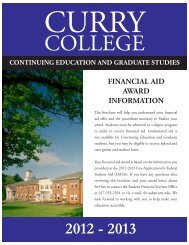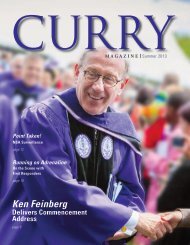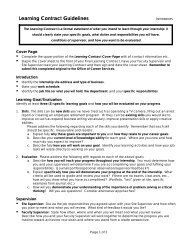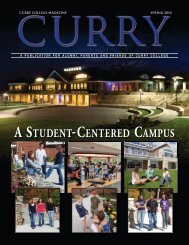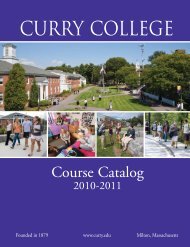Read the Curry College NEASC 2012 Self-Study Report.
Read the Curry College NEASC 2012 Self-Study Report.
Read the Curry College NEASC 2012 Self-Study Report.
You also want an ePaper? Increase the reach of your titles
YUMPU automatically turns print PDFs into web optimized ePapers that Google loves.
11<br />
and to implement <strong>the</strong> results of planning successfully. Specific examples include attaining goals<br />
relative to: increased enrollment, development of graduate programs in Management and<br />
Nursing; completion of significant capital projects including major building projects, such as <strong>the</strong><br />
Student Center.<br />
Institutional planning occurs on many levels at <strong>Curry</strong>, and <strong>the</strong>re is evidence that planning has<br />
been successful in a number of separate initiatives. An example is within Academic Affairs,<br />
where meaningful steps toward integrated planning are being taken through <strong>the</strong> development<br />
of clearly articulated self‐assessment, priority, and planning documents.<br />
Technology planning occurs through <strong>the</strong> Technology Governance Committee, which generates<br />
an annual review of technology needs and submits <strong>the</strong>m to <strong>the</strong> Budget Committee and <strong>the</strong><br />
Educational Technology Committee. Recommendations that are made throughout <strong>the</strong><br />
academic year are <strong>the</strong>n aligned with <strong>the</strong> budget process. However, a clear institutional process<br />
that integrates technology plans with o<strong>the</strong>r planning and resource allocation processes is<br />
needed, and will have to be developed in <strong>the</strong> context of <strong>the</strong> <strong>College</strong>’s strategic initiatives.<br />
The need for more integrated and systematic planning has also been identified in <strong>the</strong> area of<br />
strategic enrollment management. <strong>Curry</strong>’s strategic enrollment management efforts began to<br />
take shape over <strong>the</strong> past few years, and recently ga<strong>the</strong>red data has been used to increase<br />
awareness of external competition, to reflect on student academic performance within<br />
programs, and to elucidate program enrollment patterns. In some cases, curricular changes<br />
have been made as a result of <strong>the</strong>se efforts. The <strong>College</strong>’s current size, level of sophistication,<br />
and complexity, however, require well‐formed structures and more focused effort to drive<br />
enrollment decisions and to systematically integrate enrollment management throughout <strong>the</strong><br />
organization. To date, <strong>the</strong> main focus of strategic enrollment management has been <strong>the</strong><br />
realization of short‐term recruitment goals, but a longer‐term enrollment plan that flows from<br />
<strong>the</strong> <strong>College</strong>’s strategic directions, and outlines enrollment goals and <strong>the</strong> strategic initiatives<br />
necessary to achieve <strong>the</strong>m, is needed. There is also a need to include data relative to student<br />
persistence‐to‐degree‐completion to capture <strong>the</strong> entire enrollment picture at <strong>Curry</strong>.<br />
The recently‐launched Strategic Planning process is occurring at an opportune moment for<br />
<strong>Curry</strong>. Comprehensive strategic planning has not been undertaken in eight years; <strong>the</strong> context<br />
both within and outside of <strong>the</strong> institution has changed, and <strong>the</strong>re is recognition that<br />
understandings about <strong>the</strong> <strong>College</strong>’s mission, purposes, and goals in <strong>2012</strong> and beyond need to<br />
be crystallized and serve as <strong>the</strong> foundation for fur<strong>the</strong>r institutional development.<br />
The current strategic planning process began with a college‐wide SWOT analysis, in which effort<br />
was made to distill and understand <strong>the</strong> student, faculty, and staff voices on questions relating<br />
to <strong>the</strong> <strong>College</strong>’s mission, core values, and effectiveness. The Strategic Planning Committee used<br />
<strong>the</strong> results of <strong>the</strong> analysis to develop <strong>the</strong> plan’s core vision and values elements, strategic<br />
considerations, and strategic directions. Initiatives to support <strong>the</strong> four identified strategic<br />
directions were developed during <strong>the</strong> Fall 2011 semester through numerous open community<br />
meetings. They are: xxx<br />
<strong>Curry</strong> <strong>College</strong> <strong>2012</strong> <strong>Self</strong>-<strong>Study</strong><br />
Standard Two




